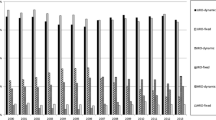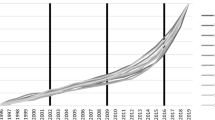Abstract
This paper attempts to provide an overview of scientific publication trends over the period of a century (1900–2017). It then drills down to three important explorations that depict world trends and the development of science, namely: the growth behaviors of different time periods; fields and research orientations; and cumulative capability patterns of different countries by size of population. To study growth behaviors, we employed logistic growth function to model the world publication trajectory. We observed that the carrying capacity of the world publication trajectory has increased, attaining a much higher level of production. The rate of publication for the period of 1990–2017 has elongated the cycle and witnessed a longer trend towards saturation. For research activities in recent decades, we noted that they were performed by coordinated entities that are endowed to chart a multidisciplinary/interdisciplinary research path. Publications were found to be oriented towards medical and industrial applications, which can be attributed to the attempts of emerging countries which aspire to develop science-based industries. The analyses and observations in this paper have enabled us to corroborate our previous findings on growth behaviors of scientific publications. We believe that these findings will allow us to theorize further on the world development of science, and realize a strong theoretical narrative for a century of publication in the near future.






Similar content being viewed by others
Notes
The use of technology derived new fields of science (e.g. computer science). In addition, the advancement of certain technologies (e.g. precision machinery, 3D printers, computing power, etc.) allowed scientists to pursue scientific experiments/research (e.g. testing and screening of lifestyle diseases in biomedical research; large scale modeling of economics activities; simulation to generate social contexts; etc.) that were thought to be impossible just a few decades ago.
It is fair to argue that the Age of Enlightenment in the eighteenth century and liberalism led to the democratization movement in the subsequent two centuries.
An online citation indexing database, a bibliometric product which was initiated by ISI.
The final updating task was done via National Tsing Hua University (NTHU)’s online library system.
The function that is fitted to the data points would enable us to project future scientific production. See Wong and Wang (2015, pp. 92–93) for more discussion on logistic growth function.
We omitted the count for 2018, as we did not manage to mine the exact total publications of that year.
This echoes the view of Leydesdorff and Wagner (2009).
See Wong and Wang (2015).
This should not lead to the view/conclusion that China and India have yet to attain sufficient competencies to pursue science. Many universities and research institutes in relatively developed provinces/cities of China (e.g. Beijing and Shanghai) are pursuing state-of-the-art scientific and technological research activities. Nonetheless, large countries like China and India tend to face issues of mobilizing (sufficient) resources to empower the scientific capabilities of less developed provinces/regions. Coordinating extensively at the horizontal level (Doner and Schneider 2016, p. 612) to advance research entities across regions and coordinating massively at the vertical level to empower all (potential) agents of change across regions are not as simple as coordinating for smaller economies.
On the other hand, some countries fell into Cold War conflict.
The top 200 titles are according to publication counts. For the first 50 years, The British Medical Journal with 68,447 articles is ranked at the top, while The Journal of the Patent and Trademark Office Society with 2132 articles is ranked at 200th.
See Wong and Goh (2015).
References
Abrahams, L., & Pogue, T. E. (2014). South Africa: The need to disrupt the co-evolution of the innovation system and inequality. In M. C. C. Soares, M. Scerri, & R. Maharajh (Eds.), Inequality and development challenges (pp. 238–302). Oxon: Routledge.
Bhattacharya, S., Shilpa, & Kaul, A. (2015). Emerging countries assertion in the global publication landscape of science: A case study of India. Scientometrics, 103(2), 387–411.
Chen, R. H. G., & Chen, C. M. (2016). Visualizing the world’s scientific publications. Journal of the Association for Information Science and Technology, 67(10), 2477–2488.
Choung, J. Y., & Hwang, H. R. (2000). National systems of innovation: Institutional linkages and performances in the case of Korea and Taiwan. Scientometrics, 48(3), 413–426.
Choung, J.-Y., & Hwang, H.-R. (2013). The evolutionary patterns of knowledge production in Korea. Scientometrics, 94(2), 629–650.
Clarivate Analytics. (2018). In Memoriam: Dr Eugene Garfield, September 16, 1925–February 26, 2017. https://clarivate.com/dr-garfield/. Accessed 8 August 2018.
Doner, R., & Schneider, B. R. (2016). The middle-income trap: More politics than economics. World Politics, 68(4), 608–644.
Feller, I., & Stern, P. C. (Eds.). (2007). A strategy for assessing science: Behavioral and social research on aging, National Research Council (US) Committee on assessing behavioral and social science research on aging. Washington, DC: National Academies Press.
Foray, D. (2006). The economics of knowledge. Cambridge: The MIT Press.
Fu, H. Z., Chuang, K. Y., Wang, M. H., & Ho, Y. S. (2011). Characteristics of research in China assessed with Essential Science Indicators. Scientometrics, 88(3), 841–862.
Grupp, H. (1994). The dynamics of science-based innovation reconsidered: Cognitive models and statistical findings. In O. Granstrand (Ed.), Economics of technology (pp. 223–251). Amsterdam: Elsevier.
Grupp, H., & Schmoch, U. (1992). Perceptions of scientification as measured by referencing between patents and papers. In H. Grupp (Ed.), Dynamics of science-based innovation (pp. 73–128). Berlin: Springer.
Gu, Y. (2004). Global knowledge management research: A bibliometric analysis. Scientometrics, 61(2), 171–190.
Hobday, M. (1997). Innovation in East Asia: The challenge to Japan. Cheltenham: Edward Elgar.
Hugh, C. (Ed.). (1911). “Publishing”, Encyclopædia Britannica (11th ed.). Cambridge: Cambridge University Press.
Jarvenpaa, H. M., Makinen, S. J., & Seppanen, M. (2011). Patent and publishing activity sequence over a technology’s life cycle. Technological Forecasting and Social Change, 78(2), 283–293.
Kostoff, R. N. (2008). Comparison of China/USA science and technology performance. Journal of Informetrics, 2, 354–363.
Kostoff, R. N. (2012). China/USA nanotechnology research output comparison—2011 update. Technological Forecasting and Social Change, 79(5), 986–990.
Kretschmer, H. (1994). Quantity and quality in ‘science of science’. Scientometrics, 30(2–3), 533–537.
Leclerc, M., & Gagné, J. (1994). International scientific cooperation: The continentalization of science. Scientometrics, 31(3), 261–292.
Lee, K., & Lim, C. (2001). Technological regimes, catching-up and leapfrogging: Findings from the Korean industries. Research Policy, 30(3), 459–483.
Leydesdorff, L., & Wagner, C. (2009). Is the United States losing ground in science? A global perspective on the world science system. Scientometrics, 78(1), 23–36.
Leydesdorff, L., & Zhou, P. (2005). Are the contribution of China and Korea upsetting the world system of science? Scientometrics, 63(3), 617–630.
Liu, W., Hu, G., Tang, L., & Wang, Y. (2015). China’s global growth in social science research: Uncovering evidence from bibliometric analyses of SSCI publications (1978–2013). Journal of Informetrics, 9, 555–569.
Mathews, J., & Cho, D.-S. (2000). Tiger technology: The creation of a semiconductor industry in East Asia. Cambridge: Cambridge University Press.
Mathews, J., & Hu, M.-C. (2007). Enhancing the role of universities in building national innovative capacity in Asia: The case of Taiwan. World Development, 35(6), 1005–1020.
Miquel, J. F., Ojasoo, T., Okubo, Y., Paul, A., & Doré, J. C. (1995). World science in 18 disciplinary areas: Comparative evaluation of the publication patterns of 48 countries over the period 1981–1992. Scientometrics, 33(2), 149–167.
Moiwo, J. P., & Tao, F. (2013). The changing dynamics in citation index publication position China in a race with the USA for global leadership. Scientometrics, 95(3), 1031–1050.
Ohno, K. (2014). Learning to industrialize: From given growth to policy-aided value creation. Abingdon: Routledge.
Panat, R. (2014). On the data and analysis of the research output of India and China: India has significantly fallen behind China. Scientometrics, 100(2), 471–481.
Penny, D. (2008). Publishing technologies: what does the future hold? Learned Publishing, 21, 39–47.
Rosenberg, N., & Nelson, R. (1994). American universities and technical advance in industry. Research Policy, 23(3), 323–348.
Samoylenko, I., Chao, T. C., Liu, W. C., & Chen, C. M. (2006). Visualizing the scientific world and its evolution. Journal of the American Society for Information Science and Technology, 57(11), 1461–1469.
Schmoch, U. (1997). Indicators and the relations between science and technology. Scientometrics, 38(1), 103–116.
Schmoch, U. (2007). Double-boom cycles and the comeback of science-push and market-pull. Research Policy, 36(7), 1000–1015.
Soares, M. C. C., & Podcameni, M. G. (2014). Inequality, innovation and development—The Brazilian experience. In M. C. C. Soares, M. Scerri, & R. Maharajh (Eds.), Inequality and development challenges (pp. 19–79). Oxon: Routledge.
Stephen, P. (2012). How economics shapes science. Cambridge: Harvard University Press.
Stokes, D. E. (1997). Pasteur’s quadrant: Basic science and technological innovation. Washington, DC: Brookings Institution Press.
Tijssen, R. J. W. (2010). Discarding the ‘basic science/applied science’ dichotomy: A knowledge utilization triangle classification system of research journals. Journal of the American Society for Information Science and Technology, 61, 1842–1852.
UN. (2013). World economic and social survey 2013: Sustainable development challenges. New York: United Nation Press.
Waltman, L., Tijssen, R. J. W., & Eck, N. J. (2011). Globalisation of science in kilometres. Journal of Informetrics, 5, 574–582.
Whitney, G. (1992). Access to third world science in international scientific and technical bibliographic databases. Scientometrics, 23(1), 201–219.
Wong, C-Y., & Lim, G. A typology of agricultural production systems: Capability building trajectories of three Asian Economies, Asia Pacific Viewpoint (forthcoming)
Wong, C.-Y., & Fung, H.-N. (2019). Post catch-up science and technology trajectories: Publishing and patenting activities of China and Korea. In W. Glanzel, H. F. Moed, U. Schmoch, & M. Thelwall (Eds.), Springer handbook of science and technology indicators (pp. 1043–1061). Heidelberg: Springer.
Wong, C.-Y., & Goh, K.-L. (2012). The sustainability of functionality development of science and technology: Papers and patents of emerging economies. Journal of Informetrics, 6(1), 55–65.
Wong, C.-Y., & Goh, K.-L. (2015). Catch-up models of science and technology: A theorization of the Asian experience from bi-logistic growth trajectories. Technological Forecasting and Social Change, 95, 312–327.
Wong, C. Y., Ng, B. K., Azizan, S. A., & Hasbullah, M. (2018). Knowledge structures of city innovation systems: Singapore and Hong Kong. Journal of Urban Technology, 25(1), 47–73.
Wong, C.-Y., & Wang, L. (2015). Trajectories of science and technology and their co-evolution in BRICS: Insights from publication and patent analysis. Journal of Informetrics, 9(1), 90–101.
Zhang, J., Yan, Y., & Guan, J. (2015). Scientific relatedness in solar energy: A comparative study between the USA and China. Scientometrics, 102(2), 1595–1613.
Zhou, P., & Bornmann, L. (2015). An overview of academic publishing and collaboration between China and Germany. Scientometrics, 102(2), 1781–1793.
Zhou, P., & Glänzel, W. (2010). In-depth analysis on China’s international cooperation in science. Scientometrics, 82(3), 597–612.
Zhou, P., & Leydesdorff, L. (2006). The emergence of China as a leading nation in science. Research Policy, 35(1), 83–104.
Acknowledgements
This work was supported by Laboratory Program for Korean Studies through the Ministry of Education of Republic of Korea and Korean Studies Promotion Service of the Academy of Korean Studies (AKS-2018-LAB-1250001). The author would like to thank Robert Tijssen for sharing the list of titles under CWTS journal classification. The author also would like to acknowledge the research supports from University of Malaya and Institute for Economic Research at Seoul National University (during my sabbatical leave in Korea).
Author information
Authors and Affiliations
Corresponding author
Appendix A
Appendix A
see Table 6.
Rights and permissions
About this article
Cite this article
Wong, CY. A century of scientific publication: towards a theorization of growth behavior and research-orientation. Scientometrics 119, 357–377 (2019). https://doi.org/10.1007/s11192-019-03048-5
Received:
Published:
Issue Date:
DOI: https://doi.org/10.1007/s11192-019-03048-5




